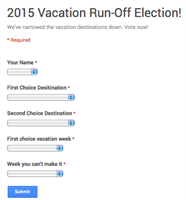Family Vacation Destination
November 20, 2014 by Sadie in Sadie & Greg
 In anticipation of the final family vacation survey results, which will be available this weekend: What I learned from designing a Family Vacation Destination survey: In anticipation of the final family vacation survey results, which will be available this weekend: What I learned from designing a Family Vacation Destination survey:
1. Everyone is unique, but decision-making requires simplification.
I received as many direct email responses from my first survey as survey responses, detailing the financial and logistical nuances of family vacation planning. Closed-ended questions were left blank and open-ended questions were used to communicate preferences and expected issues in vacation destination selection. This, along with repeat survey responses from single users, made the results of the first survey unreliable at best.
2. Desire can be simple, but motivation is complex.
Often, direct emails came with recommended destinations based not on preference, but on what appeared to be best for the group. Actual preference as determined by voting was not aligned with respondent's destination recommendations.
3. Question structure can facilitate or impede accurate information gathering.
Respondents were split on vacation dates. Those who had no preferences for time were unable to provide a first or second choice for a vacation week, because they didn't care. Those who had other summer plans were only able to only report on possible unavailability. If I could create the survey again, I would change vacation dates to be a single multi-select question with any blocker weeks, as respondents generally view dates as “available” and “not available.”
4. Stakeholders need to understand the process to trust the process.
Several respondents were dismayed by the results of the first survey because they had not selected the top vacation destination. A run-off survey was developed in order to:
1. Narrow and simplify destination decision-making
2. Add an "anytime" option for vacation week preferences
3. Create a respondent summary view after submission, so stakeholders could see survey progress.
5. The total of group preference can inform, not decide, the group's final choice.
Lots of people want to go to Hawaii, which is a great vacation destination. Unfortunately, it’s not a feasible destination for whose of us who would have to take a 15+-hour flight with a one-year old. Even if the popular majority decides on Hawaii, the family vacation won't be in Hawaii.
Sorry, kids.
That's because the missing assumption in the survey is that a family vacation includes as many members of the family as possible. In an environment where the most people have to be able to participate in order for something to occur, we are limited by the deviant cases as much as by the majority choice.
Great surveys can weigh many voices equally, provide a space for information collection, and hone in on key indicators to inform smarter decisions. However, good decision-making is still a required part of the picture. However exciting as it is to provide all members of the family with an avenue to share a “vote,” more complex financial and logistical dynamics are always at play in group choices (as the initial direct email respondents implicitly knew, using their voices to circumvent the survey, recognizing that would be a minimal part of the final decision-making process)
Should you still vote for Hawaii? Good question. It will certainly decide where the next family sub-group vacation goes. And like all election coverage, this information will likely influence voting behavior. But you still have a vote, and you should still use it, albeit within the realities of vacation destinations.
In short, the Democrats are NOT the same as the Republicans, no matter what Nader says.
|
Hi Simon!
June 06, 2014 by Adam in Sadie & Greg
 Sadie and Greg gave birth to Simon Miller Caswell at 11:31 a.m. He's 8 lbs, 1oz. Everyone is happy, healthy, and tired. Sadie and Greg gave birth to Simon Miller Caswell at 11:31 a.m. He's 8 lbs, 1oz. Everyone is happy, healthy, and tired.
|